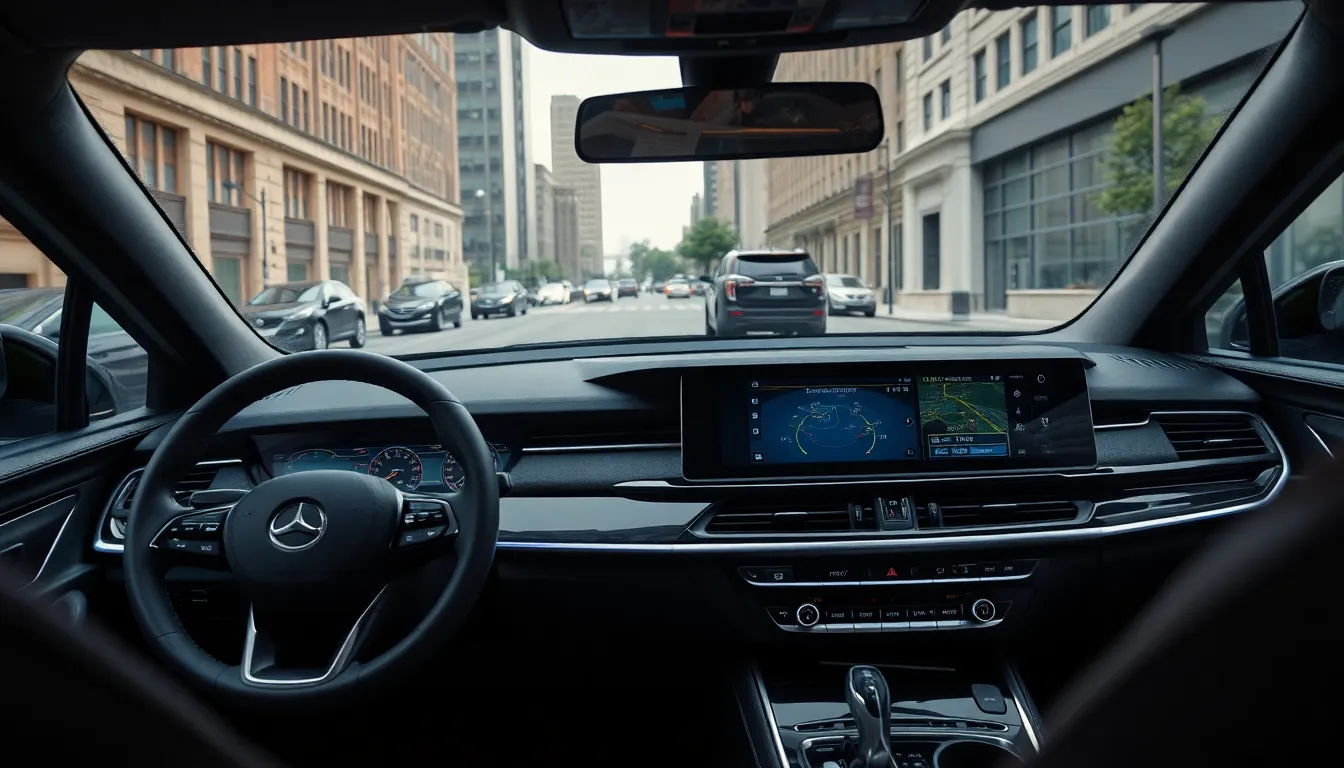Table of Contents
ToggleIn today’s fast-paced world, car electronics are more than just fancy gadgets; they’re essential companions on the road. From navigation systems that keep drivers from making wrong turns into the abyss to audio systems that transform mundane commutes into concert hall experiences, these tech wonders have revolutionized the driving experience.
Overview of Car Electronics
Car electronics include various components that enhance the overall driving experience. Navigation systems serve as critical tools for modern drivers, increasing safety and efficiency. These systems provide real-time directions, traffic updates, and route optimization, preventing unnecessary delays.
Advanced audio systems contribute significantly to passenger enjoyment. High-quality speakers and multimedia capabilities allow for seamless integration of devices. Connectivity features such as Bluetooth and USB ports enable drivers and passengers to enjoy their favorite music and podcasts without distraction.
Safety features also play a vital role in car electronics. Backup cameras, adaptive cruise control, and lane departure warnings help minimize risks while driving. These technologies assist drivers in making informed decisions on the road.
Additionally, infotainment systems have transformed vehicles into mobile entertainment hubs. Touchscreen interfaces and voice recognition technology facilitate easy access to navigation, audio, and communication options. Drivers can focus on the road while controlling various functions.
Battery management systems monitor the health of electrical components within the vehicle. This technology ensures optimal performance and longevity of car electronics. Maintaining a strong battery extends the life of these essential systems.
As technology progresses, car electronics continue to evolve, integrating more advanced features. Electric and hybrid vehicles often showcase innovative electronics aimed at improving energy efficiency. Such advancements reflect the ongoing shift toward sustainability in automotive design.
Key Components of Car Electronics

Car electronics encompass various components that enhance the driving experience and ensure vehicle safety.
Infotainment Systems
Infotainment systems integrate audio, navigation, and communication functions into a seamless interface. Touchscreen displays facilitate easy access to music and maps. Many systems support smartphone connectivity, allowing users to stream content directly from their devices. Voice recognition technology simplifies interaction, enabling hands-free operation for safer driving. Upgrading to advanced infotainment systems can significantly enhance user experience and overall enjoyment of the ride.
Safety Features
Safety features play a critical role in accident prevention and enhancing driver confidence. Backup cameras provide real-time visuals of the area behind the vehicle, assisting in parking maneuvers. Adaptive cruise control automatically adjusts speed to maintain safe distances from other vehicles. Lane departure warnings alert drivers when drifting from their lane, adding an extra layer of safety. Integrating these safety technologies into vehicles significantly reduces risks on the road.
Engine Management Systems
Engine management systems optimize vehicle performance and fuel efficiency. These systems monitor critical parameters, such as air-fuel mixture and ignition timing, ensuring the engine runs smoothly. Real-time data analysis contributes to emissions reduction and improves overall engine health. By adjusting to driving conditions, modern engine management systems enhance reliability and performance. Implementing advanced engine technologies can lead to substantial benefits in performance and reduced environmental impact.
Trends in Car Electronics
Car electronics reflect ongoing advancements that enhance vehicle functionality and user experience. As technology develops, connectivity and integration become vital components.
Connectivity and Integration
Connectivity offers seamless communication between devices and the vehicle’s systems. Many vehicles now support smartphone integration, allowing drivers to access apps easily. Features such as Apple CarPlay and Android Auto enable hands-free calls and music streaming. Bluetooth technology connects smartphones to infotainment systems for effortless audio playback. In addition, vehicles equipped with built-in Wi-Fi hotspots provide internet access, enriching passenger entertainment. The Internet of Things (IoT) connects vehicle settings to mobile devices, enabling remote monitoring and control. Enhanced infotainment systems showcase real-time updates, traffic conditions, and navigation, making drives more efficient and enjoyable.
Autonomous Driving Technologies
Autonomous driving technologies represent a significant leap forward in automotive safety and convenience. Today’s vehicles utilize advanced sensors and cameras to detect surroundings accurately. Lidar, radar, and vision systems work together to assist in lane-keeping and adaptive cruise control. These systems not only optimize driving comfort but also improve overall safety. As the technology matures, higher levels of automation, such as hands-free driving and parking assistance, gain traction. Current regulations support the development and testing of autonomous vehicles, fostering innovation. Consumers increasingly embrace these advancements, eager for safer, more autonomous driving experiences.
Benefits of Advanced Car Electronics
Advanced car electronics offer numerous benefits that enhance the overall driving experience. They significantly improve safety features, providing drivers with essential support during vehicle operation. For instance, backup cameras and lane departure warnings help prevent accidents, allowing for safer maneuvers on the road.
Enhanced navigation systems offer real-time traffic updates and route optimization. Drivers benefit from reduced travel times and minimized frustration when navigating unfamiliar areas. Infotainment systems also play a crucial role, integrating navigation, audio, and communication into a single interface, streamlining the user experience.
Powerful audio systems elevate passenger enjoyment. High-quality speakers and seamless device connectivity ensure a rich listening environment, making commutes more pleasant. Additionally, built-in Wi-Fi hotspots increase entertainment options for passengers, allowing them to stay connected throughout the ride.
Performance optimization remains another key advantage of advanced electronics. Engine management systems monitor vital vehicle parameters, ensuring maximum efficiency and responsiveness. These systems adjust to varying driving conditions, which can lead to better fuel economy.
Autonomous driving technologies represent a significant advancement in car electronics. These features, including adaptive cruise control and lane-keeping assist, enhance convenience and safety. Consumers embrace these innovations, eager for more reliable and automated driving experiences.
Battery management systems monitor the health and performance of electrical components. By ensuring optimal functioning, these systems extend the longevity of car electronics. As technology continues to evolve, advancements in electric and hybrid vehicles reflect a commitment to sustainability, aligning with modern consumer preferences for environmentally friendly solutions.
Challenges and Considerations
Car electronics present various challenges that require careful consideration. First, ensuring compatibility among different systems often complicates integration, making it critical to verify that components work seamlessly together. Budget constraints frequently limit the choice of advanced features, prompting consumers to weigh affordability against desired technology.
Reliability of hardware plays a significant role in vehicle performance. Frequent malfunctions can lead to safety issues, necessitating routine maintenance and updates. The complexity of installation processes may discourage some users, especially those lacking technical expertise. Proper installation can greatly affect functionality and performance.
Data privacy also arises as a common concern with connected car electronics. Protecting personal information becomes essential, especially with systems that connect to the Internet of Things (IoT). Manufacturers must prioritize security measures to safeguard user data from potential breaches.
Vehicle software needs regular updates to enhance performance and address emerging vulnerabilities. Without timely updates, systems may become outdated quickly and less effective. Therefore, users should stay informed about available updates to maintain system integrity.
Navigating the evolving landscape of regulations presents another challenge. Autonomous driving technologies undergo continuous scrutiny as governments establish guidelines for safety and performance. Adapting to these changes can be daunting for both manufacturers and consumers.
Market trends signify a shift toward eco-friendly solutions. As electric and hybrid vehicles gain traction, car electronics must evolve to support energy efficiency and sustainability. Manufacturers need to focus on developing systems that align with these trends to meet consumer demand.
Awareness of these challenges and considerations helps consumers make informed decisions about car electronics, optimizing their driving experience while ensuring safety and enjoyment on the road.
Car electronics are reshaping the driving experience by integrating safety and convenience into everyday journeys. As vehicles become more connected and equipped with advanced technologies, drivers can enjoy enhanced navigation, superior audio quality, and increased safety features that significantly reduce risks on the road.
The ongoing evolution of these systems reflects a commitment to sustainability and efficiency, paving the way for smarter, more eco-friendly vehicles. With the rise of autonomous driving technologies and the importance of data privacy, consumers are encouraged to stay informed and make choices that align with their needs and preferences.
Ultimately, embracing these advancements not only improves driving experiences but also contributes to safer and more enjoyable commutes.






